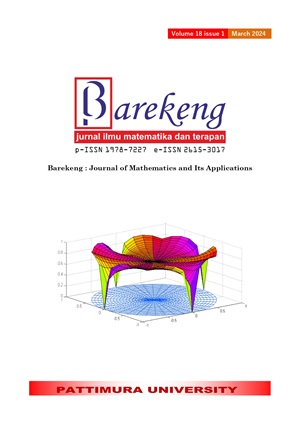NUMERICAL ANALYSIS IN ARTERIAL STENOSIS AFFECTED BY ISCHEMIC HEART DISEASE USING FINITE VOLUME METHOD
Abstract
Atherosclerosis is the narrowing of blood vessels caused by the buildup of cholesterol plaque on the walls of the arteries. Excessive buildup of cholesterol plaque disrupts the circulatory system, thereby affecting the speed and pressure of blood flow. In the long term, atherosclerosis can cause ischemic heart disease. This study aims to analyze the influence of stenosis, initial velocity, and diameter on the velocity and pressure of blood flow in narrowed arteries that cause ischemic heart disease. In this research, a Navier Stoke mathematical equation model was built which was solved using the finite volume method with SIMPLE discretization (Semi Implicit Method for Pressure Linked Equations). Finite volume methods are used to analyze unstructured objects such as blood flow. SIMPLE discretization is implemented simply in two and three dimensions with a system of equations containing fluid motion. Matlab and Fluent are software used for process simulations, Matlab for visualizing graphs of numerical calculation results, and Fluent for visualizing blood flow. Based on the simulation results, it can be concluded that the smaller the diameter, the greater the stenosis, and the greater the initial velocity, the greater the blood flow velocity. On the contrary, the diameter gets smaller, the stenosis gets bigger, and the initial velocity gets bigger so that the pressure on the blood flow gets smaller. Blood flow simulation has the potential to contain ischemic heart disease if the maximum speed produced is greater than the maximum normal blood speed, namely 0.45 m/s.
Downloads
References
A. Fatahillah, A. L. Anggraini, and S. Setiawani, “Numerical analysis of blood flow in abdominal aortic aneurysm using finite volume method,” DesimalJurnal Mat., vol. 5, no. 2, pp. 131–142, 2022, doi: 10.24042/djm.
S. Aji et al., “Nutritional status and anemia on wound healing process in post cesarean section patients,” Int. J. Nurs. Midwifery Res., vol. 1, no. 1, pp. 58–61, 2022, [Online]. Available: https://journals.iarn.or.id/index.php/ners/index.
Y. Hippy, N. R. Mapisamang, and R. D. Supu, “COMPARISON OF BLOOD PRESSURE IN SITTING , STANDING , AND LYING POSITIONS IN KEEPING HOMEOSTATIS,” J. Ilm. dr. Aloei Saboe, vol. 10, no. 2, pp. 1–9, 2023, doi: https://doi.org/10.47918/jias.v10i2.263.
D. Pirri, M. Fragiadaki, and P. C. Evans, “Diabetic atherosclerosis: Is there a role for the hypoxia-inducible factors?,” Biosci. Rep., vol. 40, no. 8, pp. 1–12, 2020, doi: 10.1042/BSR20200026.
E. Boniewska-Bernacka, A. Pańczyszyn, and M. Klinger, “Telomeres and telomerase in risk assessment of cardiovascular diseases,” Exp. Cell Res., vol. 397, no. 2, pp. 45–52, 2020, doi: 10.1016/j.yexcr.2020.112361.
J. Oh et al., “Association of long-term exposure to PM2.5 and survival following ischemic heart disease,” Environ. Res., vol. 216, no. P1, p. 114440, 2023, doi: 10.1016/j.envres.2022.114440.
D. Lopes et al., “Analysis of finite element and finite volume methods for fluid-structure interaction simulation of blood flow in a real stenosed artery,” Int. J. Mech. Sci., vol. 207, no. June, p. 106650, 2021, doi: 10.1016/j.ijmecsci.2021.106650.
J. Ritonga and D. Suryana, “Perbandingan Kecepatan Konvergensi Akar Persamaan Non Linier Metode Titik Tetap dengan Metode Newton Raphson Menggunakan Matlab,” Inf. (Jurnal Inform. dan Sist. Informasi), vol. 11, no. 2, pp. 51–64, 2019, doi: 10.37424/informasi.v11i2.17.
A. Fatahillah, M. A. Masyhudi, and T. B. Setiawan, “Numerical analysis of air pollutant dispersion in steam power plant area using the finite volume method,” J. Phys. Conf. Ser., vol. 1490, no. 1, 2020, doi: 10.1088/1742-6596/1490/1/012002.
W. Jeong and J. Seong, “Comparison of effects on technical variances of computational fluid dynamics (CFD) software based on finite element and finite volume methods,” Int. J. Mech. Sci., vol. 78, pp. 19–26, 2014, doi: 10.1016/j.ijmecsci.2013.10.017.
M. Istiqomah, D. Dafik, and A. Fatahillah, “Pemodelan Matematika Pada Kasus Kecanduan Game Online Menggunakan Metode Runge-Kutta Orde 14,” Limits J. Math. Its Appl., vol. 18, no. 2, p. 129, 2021, doi: 10.12962/limits.v18i2.6854.
M. U. Nuha, A. Fatahillah, and S. Setiawani, “Analisis Numerik Aliran Udara pada Rongga Hidung akibat Penyakit Sinusitis menggunakan Metode Volume Hingga,” Limits J. Math. Its Appl., vol. 19, no. 2, p. 217, 2022, doi: 10.12962/limits.v19i2.13683.
S. Nadeem et al., “Modeling and numerical simulation of non-Newtonian arterial blood flow for mild to severe stenosis,” Alexandria Eng. J., vol. 72, pp. 195–211, 2023, doi: 10.1016/j.aej.2023.03.088.
V. S. . Shahane s, “A semi-implicit meshless method for incompressible flows in complex geometries,” J. Comput. Phys., vol. 472, no. 111715, 2023, doi: https://doi.org/10.1016/j.jcp.2022.111715.
A. Karudin, “Analisis Numerik Pengaruh Sudut Sudu Pengarah Difuser Jet Swirling dan Grille Terhadap Distribusi Sifat-Sifat Termodinamika Udara dalam Ruang Terkondisi,” INVOTEK J. Inov. Vokasional dan Teknol., vol. 20, no. 2, pp. 117–128, 2020, doi: 10.24036/invotek.v20i2.789.
Copyright (c) 2024 Arif Fatahillah, Alfiani Dyah Pratiwi, Susi Setiawani, Arika Indah Kristiana, Robiatul Adawiyah

This work is licensed under a Creative Commons Attribution-ShareAlike 4.0 International License.
Authors who publish with this Journal agree to the following terms:
- Author retain copyright and grant the journal right of first publication with the work simultaneously licensed under a creative commons attribution license that allow others to share the work within an acknowledgement of the work’s authorship and initial publication of this journal.
- Authors are able to enter into separate, additional contractual arrangement for the non-exclusive distribution of the journal’s published version of the work (e.g. acknowledgement of its initial publication in this journal).
- Authors are permitted and encouraged to post their work online (e.g. in institutional repositories or on their websites) prior to and during the submission process, as it can lead to productive exchanges, as well as earlier and greater citation of published works.






1.gif)



